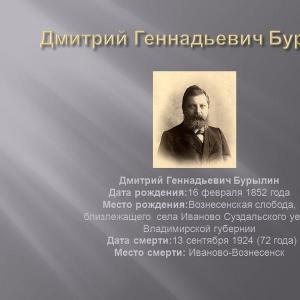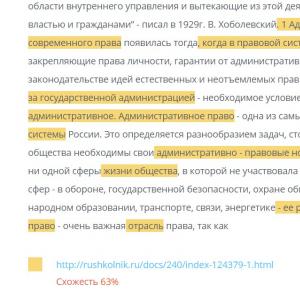What does arithmetic mean. Scientific and technical encyclopedic dictionary What is arithmetic, what does it mean and how it is spelled correctly
Arithmetic
Arithmetic g.
1.
A branch of mathematics that studies the simplest properties of numbers, ways of writing them and actions on them.
2.
An academic subject containing the basics of this section of mathematics.
3. colloquial
A textbook describing the content of this academic subject.
Dictionary Efremova... T.F. Efremova. 2000.
Synonyms:
See what "Arithmetic" is in other dictionaries:
- (from the Greek arithmos number, and toche art). Science, which has numbers as its subject. Dictionary of foreign words included in the Russian language. Chudinov AN, 1910. ARITHMETICS from the Greek. arithmos, number, and techne, art. The science of numbers. ... ... Dictionary of foreign words of the Russian language
Female, Greek the theory of counting, the science of calculus; the basis of all mathematics (the science of quantities, of the measurable); · Old. counting or digital wisdom; account, deduction, numerical estimate, calculation. Arithmetic, arithmetic, related to it. Arithmetician, ... ... Dahl's Explanatory Dictionary
Digital business, digital science, digital, counting Dictionary of Russian synonyms. arithmetic digits (outdated) Dictionary of synonyms of the Russian language. Practical guide. M .: Russian language. Z.E. Aleksandrova. 2011 ... Synonym dictionary
- (from the Greek words ariJmoV number and tecnh art) part of mathematics, which deals with the study of the properties of certain specific quantities; in a closer sense, A. is the science of numbers expressed in numbers, and deals with actions on numbers. Can i… … Encyclopedia of Brockhaus and Efron
Modern encyclopedia
- (from the Greek arithmos number) part of mathematics; studies the simplest properties of numbers, primarily natural (positive integers) and fractional numbers, and actions on them. The development of arithmetic led to the separation of algebra and theory numbers from it ... Big Encyclopedic Dictionary
ARITHMETICS, a method of calculation using addition, subtraction, multiplication and division. A formal axiomatic basis for these operations was provided by Giuseppe Peano in late XIX at. Based on some postulates, for example, that there is only one ... ... Scientific and technical encyclopedic Dictionary
ARITHMETICS, arithmetic, pl. no, wives. (Greek arithmetike). The doctrine of numbers, expressed by numbers, and actions on them. Ushakov's explanatory dictionary. D.N. Ushakov. 1935 1940 ... Ushakov's Explanatory Dictionary
ARITHMETIC, and, wives. 1. A branch of mathematics that studies the simplest properties of numbers, expressed in numbers, and actions on them. 2. transfer. Same as counting (in 2 digits) (colloquial). Checked the expenses turned out to be disappointing. | adj. arithmetic, oh, ... ... Ozhegov's Explanatory Dictionary
arithmetic - - [A.S. Goldberg. The English Russian Energy Dictionary. 2006] Topics energy in general EN arithmetics ... Technical translator's guide
Arithmetic - (from the Greek arithmos number), a part of mathematics that studies the simplest properties of integers and fractional numbers and actions on them. It arose in ancient times from the practical needs of counting, measuring distances, time, etc. Improvement ... ... Illustrated Encyclopedic Dictionary
Books
- Arithmetic, Kiselev Andrey Petrovich. 2017 marks 165 years since the birth of A.P. Kiselev. His first school textbook on arithmetic was published in 1884. In 1938 it was approved as an arithmetic textbook for 5-6 ...
Arithmetic is the most basic, basic branch of mathematics. It owes its origin to the needs of people for counting.
Mental arithmetic
What is called mental arithmetic? Mental arithmetic is a method of teaching rapid counting that came from antiquity.
Currently, unlike the previous one, teachers are trying not only to teach children the speed of counting, but also trying to develop thinking.
The learning process itself is based on the use and development of both hemispheres of the brain. The main thing is to be able to use them together, because they complement each other.
Really, left hemisphere is responsible for logic, speech and rationality, and the right is for imagination.
The training program includes teaching the job and using a tool such as abacus.
Abacus is the main tool in the study of mental arithmetic, because students learn to work with them, turn over the knuckles and understand the essence of counting. Over time, the abacus becomes your imagination, and the trainees imagine them, rely on this knowledge and solve examples.
Feedback on these teaching methods is very positive. There is one drawback - training is paid, and not everyone can afford it. Therefore, the path of a genius depends on the financial situation.
Mathematics and arithmetic
Mathematics and arithmetic are closely related concepts, or rather arithmetic is a branch of mathematics that deals with numbers and calculations (operations with numbers).
Arithmetic is the main section, and therefore the foundation of mathematics. The basis of mathematics is the most important concepts and operations that form the basis on which all subsequent knowledge is built. The main operations include: addition, subtraction, multiplication, division.
Arithmetic is usually taught at school from the very beginning of training, that is. from the first class. Children master the base of mathematics.
Addition - this is an arithmetic operation, during which two numbers are added, and their result will be a new one - the third.
a + b \u003d c.
Subtraction - this is an arithmetic operation, during which the second number is subtracted from the first number, and the result will be the third.
The addition formula is expressed as follows: a - b \u003d c.
Multiplication - this is an action, as a result of which the sum of identical terms is found.
The formula for this action is: a1 + a2 +… + an \u003d n * a.
DivisionIs a splitting into equal parts of a number or variable.

Sign up for the course "Speeding Up Verbal Counting, NOT Mental Arithmetic" to learn how to quickly and correctly add, subtract, multiply, divide, square numbers and even extract roots. In 30 days, you will learn how to use light tricks to simplify arithmetic operations. Each lesson has new techniques, clear examples, and helpful assignments.

Teaching arithmetic
Arithmetic is taught within the walls of the school. From the first grade, children begin to study the basic and main section of mathematics - arithmetic.
Adding numbers
Arithmetic grade 5
In the fifth grade, the student begins to study such topics as: fractional numbers, mixed numbers. You can find information about operations with these numbers in our articles on the corresponding operations.
Fractional number Is the ratio of two numbers to each other, or the numerator to the denominator. A fractional number can be replaced by a division operation. For example, ¼ \u003d 1: 4.
Mixed number Is a fractional number, with only the integer part highlighted. The whole part is highlighted provided that the numerator is greater than the denominator. For example, there was a fraction: 5/4, it can be transformed by highlighting the whole part: 1 and ¼.
Examples for training:
Task number 1:

Task number 2:

Arithmetic grade 6
In the 6th grade, the topic of converting fractions to lowercase notation appears. What does it mean? For example, given the fraction ½, it will be 0.5. ¼ \u003d 0.25.
Examples can be written in the following style: 0.25 + 0.73 + 12/31.
Examples for training:
Task number 1:

Task number 2:

Games for developing oral counting and counting speed
There are great games to help you develop your account, help you develop mathematical ability and mathematical thinking, verbal counting and counting speed! You can play and develop! You are interested? Read short articles on games and be sure to give yourself a try.
Game "Quick Count"
The fast counting game will help you speed up your oral counting. The essence of the game is that in the picture presented to you, you will need to choose a yes or no answer to the question "are there 5 identical fruits?" Follow your goal, and this game will help you with this.

Game "Mathematical Comparisons"
The game "Mathematical Comparisons" will require you to compare two numbers at a time. That is, you have to choose one of the two numbers as quickly as possible. Remember that time is limited, and the more you answer correctly, the better your math skills will develop! Let's try?

Fast addition game
The Fast Add game is an excellent fast counting simulator. The essence of the game: given a 4x4 field, that is. 16 numbers, and above the field is the seventeenth number. Your goal: Use sixteen numbers to make 17 using the addition operation. For example, if you have the number 28 written above the field, then in the field you need to find 2 such numbers that will add up to the number 28. Are you ready to try your hand? Then go ahead, train!

Developing phenomenal oral counting
We've just covered the tip of the iceberg, to get a better understanding of math - sign up for our course: Speeding up verbal counting - NOT mental arithmetic.
From the course, you will not only learn dozens of techniques for simplified and quick multiplication, addition, multiplication, division, percent calculation, but also work them out in special tasks and educational games! Verbal counting also requires a lot of attention and concentration, which are actively trained when solving interesting problems.

Speed \u200b\u200breading in 30 days
Increase your reading speed by 2-3x in 30 days. From 150-200 to 300-600 words per minute or from 400 to 800-1200 words per minute. The course uses traditional exercises for the development of speed reading, techniques that speed up the work of the brain, the method of progressively increasing the speed of reading, the psychology of speed reading and the questions of the course participants are discussed. Suitable for children and adults who read up to 5000 words per minute.
Development of memory and attention in a child 5-10 years old
Purpose of the course: to develop memory and attention in a child so that it would be easier for him to study at school, so that he could better remember.
Our acquaintance with mathematics begins with arithmetic, the science of number. One of the first Russian textbooks of arithmetic, written by L.F. of the most dignified arithmeticists, invented and stated. " With arithmetic, we enter, as MV Lomonosov said, into the “gates of learning” and begin our long and difficult, but fascinating path of understanding the world.
The word "arithmetic" comes from the Greek arithmos, which means "number." This science studies actions on numbers, various rules for dealing with them, teaches how to solve problems that reduce to addition, subtraction, multiplication and division of numbers. Arithmetic is often thought of as a first step in mathematics, on the basis of which it is possible to study its more complex sections - algebra, mathematical analysis, etc. Even whole numbers - the main object of arithmetic - are referred when viewed general properties and patterns, to higher arithmetic, or number theory. Such a view of arithmetic, of course, has grounds - it really remains the "alphabet of counting", but the alphabet "most useful" and "easy to understand."
Arithmetic and geometry are longtime companions of man. These sciences appeared when the need arose to count objects, measure land plots, divide production, keep track of time.
Arithmetic originated in the countries of the Ancient East: Babylon, China, India, Egypt. For example, the Egyptian Rinda papyrus (named after its owner G. Rinda) dates back to the 20th century. BC. Among other information, it contains the expansion of a fraction into the sum of fractions with a numerator equal to one, for example:
The treasures of mathematical knowledge accumulated in the countries of the Ancient East were developed and continued by scientists Ancient Greece... Many names of scientists involved in arithmetic in ancient world, history has preserved for us - Anaxagoras and Zeno, Euclid (see Euclid and his "Beginnings"), Archimedes, Eratosthenes and Diophantus. The name of Pythagoras (VI century BC) sparkles here as a bright star. The Pythagoreans (students and followers of Pythagoras) worshiped numbers, believing that they contain all the harmony of the world. Individual numbers and pairs of numbers were assigned special properties... The numbers 7 and 36 were in high esteem, at the same time attention was paid to the so-called perfect numbers, friendly numbers, etc.
In the Middle Ages, the development of arithmetic is also associated with the East: India, the countries of the Arab world and Central Asia... From the Indians came to us the numbers that we use, zero and positional number system; from al-Kashi (XV century), who worked at the Samarkand observatory of Ulugbek, - decimal fractions.
Thanks to the development of trade and the influence of oriental culture since the XIII century. interest in arithmetic is growing in Europe. It is worth remembering the name of the Italian scientist Leonardo of Pisa (Fibonacci), whose composition "The Book of the Abacus" introduced Europeans to the main achievements of mathematics in the East and was the beginning of many studies in arithmetic and algebra.
Along with the invention of printing (mid-15th century), the first printed mathematical books appeared. The first printed book on arithmetic was published in Italy in 1478. In the "Complete arithmetic" by the German mathematician M. Stiefel (beginning of the 16th century) there are already negative numbers and even the idea of \u200b\u200btaking logarithms.
From about the XVI century. the development of purely arithmetic questions merged into the mainstream of algebra - as a significant milestone, one can note the appearance of the works of the scientist from France F. Vieta, in which numbers are indicated by letters. From that time on, the basic arithmetic rules were finally realized from the standpoint of algebra.
The main object of arithmetic is number. Natural numbers, i.e. the numbers 1, 2, 3, 4, ... etc., arose from the account of specific objects. Many millennia passed before man learned that two pheasants, two hands, two people, etc. can be called the same word "two". An important task of arithmetic is to learn to overcome the specific meaning of the names of the counted objects, to be distracted from their shape, size, color, etc. Fibonacci already has a task: “Seven old women are going to Rome. Each has 7 mules, each mule carries 7 sacks, each sack contains 7 loaves, each bread contains 7 knives, each knife has 7 sheaths. How many are all? " To solve the problem, you will have to put together old women, mules, sacks, and bread.
The development of the concept of number - the appearance of zero and negative numbers, ordinary and decimal fractions, ways of writing numbers (numbers, designations, number systems) - all this has a rich and interesting history.
“The science of numbers is understood as two sciences: practical and theoretical. Practical studies study numbers insofar as it is a question of numbers counted. This science is used in market and civil affairs. The theoretical science of numbers studies numbers in the absolute sense, abstracted by the mind from bodies and everything that lends itself to counting. " al-Farabi

In arithmetic, numbers are added, subtracted, multiplied, and divided. The art of quickly and accurately performing these operations on any numbers has long been considered the most important task of arithmetic. Now, in our minds or on a piece of paper, we do only the simplest calculations, more and more often entrusting more complex computational work to microcalculators, which are gradually replacing devices such as abacus, adding machine (see Computing), slide rule. However, the operation of all computers - simple and complex - is based on the simplest operation - the addition of natural numbers. It turns out that the most complex calculations can be reduced to addition, only this operation must be done many millions of times. But here we are entering another area of \u200b\u200bmathematics, which originates in arithmetic - computational mathematics.
Arithmetic operations on numbers have a variety of properties. These properties can be described in words, for example: "The sum does not change from the change of places of the terms", can be written in letters:, can be expressed in special terms.
For example, this property of addition is called displacement or commutative law. We apply the laws of arithmetic often out of habit without realizing it. Often pupils at school ask: "Why learn all these transposable and combination laws, after all, it is already so clear how to add and multiply numbers?" In the XIX century. mathematics took an important step - it began to systematically add and multiply not only numbers, but also vectors, functions, displacements, tables of numbers, matrices and much more, and even just letters, symbols, not really caring about their specific meaning. And here it turned out that the most important thing is what laws these operations obey. The study of operations on arbitrary objects (not necessarily on numbers) is already a field of algebra, although this problem is based on arithmetic and its laws.
Arithmetic contains many rules for solving problems. In old books one can find problems for the "triple rule", for "proportional division", for the "method of weights", for the "false rule", etc. Most of these rules are now outdated, although the tasks that were solved with their help are by no means outdated. The famous problem about a pool filled with several pipes is at least two thousand years old, and still not easy for schoolchildren. But if earlier to solve this problem it was necessary to know a special rule, nowadays already junior schoolchildren are taught to solve such a problem by introducing the letter designation of the desired value. Thus, arithmetic problems led to the need to solve equations, and this is again an algebra problem.
|
PYTHAGORAS
There are no written documents about Pythagoras of Samos, and it is difficult to reconstruct the true picture of his life and achievements based on later evidence. It is known that Pythagoras left his native island of Samos in the Aegean Sea off the coast of Asia Minor in protest against the tyranny of the ruler and already at a mature age (according to legend at 40) appeared in the Greek city of Crotone in southern Italy. Pythagoras and his followers - the Pythagoreans - formed a secret alliance that played a significant role in life greek colonies in Italy. The Pythagoreans recognized each other by the star-shaped pentagon - the pentagram. The philosophy and religion of the East greatly influenced the teachings of Pythagoras. He traveled a lot to the countries of the East: he was in Egypt and in Babylon. There Pythagoras also became acquainted with Eastern mathematics. Mathematics became a part of his teaching, and an essential part. The Pythagoreans believed that the secret of the world was hidden in the numerical laws. The world of numbers lived a special life for the Pythagorean, numbers had their own special life meaning. Numbers equal to the sum of their divisors were perceived as perfect (6, 28, 496, 8128); pairs of numbers were called friendly, each of which was equal to the sum of the divisors of the other (for example, 220 and 284). Pythagoras was the first to divide numbers into even and odd, prime and composite, and introduced the concept of a figured number. In his school, Pythagorean triples of natural numbers were considered in detail, in which the square of one was equal to the sum of the squares of the other two (see Fermat's great theorem). The saying is attributed to Pythagoras: "Everything is number." He wanted to reduce the whole world to numbers (and he meant only natural numbers), and mathematics in particular. But in the school of Pythagoras itself, a discovery was made that violated this harmony. It has been proven that it is not a rational number, i.e. not expressed in terms of natural numbers. Naturally, Pythagoras' geometry was subordinated to arithmetic, this was clearly manifested in the theorem bearing his name and later became the basis for the application of numerical methods in geometry. (Later, Euclid again brought geometry to the fore, subordinating algebra to it.) Apparently, the Pythagoreans knew the correct bodies: a tetrahedron, a cube, and a dodecahedron. Pythagoras is credited with the systematic introduction of evidence into geometry, the creation of planimetry of rectilinear figures, the doctrine of similarity. The doctrine of arithmetic, geometric and harmonic proportions, averages, is associated with the name of Pythagoras. It should be noted that Pythagoras considered the Earth to be a ball moving around the Sun. When in the XVI century. the church began to fiercely persecute the teachings of Copernicus, this doctrine was persistently called Pythagorean. |
|
ARCHIMEDES
More is known about Archimedes, the great mathematician and mechanic, than about other ancient scientists. First of all, the year of his death is reliable - the year of the fall of Syracuse, when the scientist was killed by a Roman soldier. However, the historians of antiquity Polybius, Livy, Plutarch said little about his mathematical merits, from them to our times information about the miraculous inventions of the scientist made during the service with Tsar Hieron II came down. The story of the king's golden crown is known. Archimedes checked the purity of its composition with the help of the law of buoyancy he found, and his exclamation "Eureka!" "Found!". Another legend tells that Archimedes built a system of blocks, with the help of which one man was able to launch the huge ship "Syrakosia". The words of Archimedes, spoken then, became winged: "Give me a fulcrum, and I will turn the Earth." The engineering genius of Archimedes manifested itself with particular force during the siege of Syracuse, a wealthy trading city on the island of Sicily. The warriors of the Roman consul Marcellus were detained for a long time at the city walls by unprecedented machines: powerful catapults were aiming at stone blocks, throwing machines were installed in the loopholes, throwing out hail of cannonballs, coastal cranes turned beyond the walls and threw enemy ships with stone and lead blocks, hooks grabbed ships and throwing them down from a great height, systems of concave mirrors (in some stories - shields) set fire to ships. In the "History of Marcellus" Plutarch describes the horror that reigned in the ranks of the Roman soldiers: "As soon as they noticed that a rope or a log was shown from behind the fortress wall, they fled with a cry that Archimedes had invented a new machine for their destruction." ... Archimedes' contribution to the development of mathematics is also enormous. The spiral of Archimedes (see Spirals), described by a point moving in a rotating circle, stood apart from the many curves known to his contemporaries. The next kinematically defined curve - the cycloid - appeared only in the 17th century. Archimedes learned to find the tangent to his spiral (and his predecessors knew how to draw tangents only to conical sections), found the area of \u200b\u200bits coil, as well as the area of \u200b\u200bthe ellipse, the surface of the cone and the ball, the volumes of the ball and the spherical segment. He was especially proud of the ratio of the volume of the ball and the cylinder described around it, which he discovered, which is 2: 3 (see Inscribed and Described Figures). Archimedes also dealt a lot with the problem of squaring the circle (see Famous Problems of Antiquity). The scientist calculated the ratio of the circumference to the diameter (number) and found that it lies between and. The method he created for calculating the circumference and area of \u200b\u200ba figure was an essential step towards the creation of differential and integral calculus, which appeared only 2000 years later. Archimedes also found the sum of an infinite geometric progression with a denominator. In mathematics, this was the first example of an infinite series. An important role in the development of mathematics was played by his work "Psammit" - "On the number of grains of sand", in which he shows how, with the help of the existing number system, it is possible to express arbitrarily large numbers. As a reason for his reasoning, he uses the problem of counting the number of grains of sand inside the visible universe. Thus, the then existing opinion about the presence of the mysterious "largest numbers" was refuted. |
Among the important concepts that arithmetic introduced, proportions and percentages should be noted. Most of the concepts and methods of arithmetic are based on comparing different relationships between numbers. In the history of mathematics, the process of merging arithmetic and geometry has been going on for many centuries.
It is possible to clearly trace the "geometrization" of arithmetic: complex rules and patterns expressed by formulas become clearer if it is possible to depict them geometrically. An important role in mathematics itself and its applications is played by the reverse process - the translation of visual, geometric information into the language of numbers (see Graphic calculations). This translation is based on the idea of \u200b\u200bthe French philosopher and mathematician R. Descartes on the determination of points on a plane by coordinates. Of course, this idea had already been used before him, for example, in maritime affairs, when it was necessary to determine the location of a ship, as well as in astronomy and geodesy. But it is from Descartes and his students that the consistent application of the coordinate language in mathematics comes. And nowadays, when managing complex processes (for example, flight spacecraft) prefer to have all information in the form of numbers, which are processed by a computer. If necessary, the machine helps a person to translate the accumulated numerical information into the language of the picture.
You see that, speaking about arithmetic, we always go beyond its limits - into algebra, geometry, and other branches of mathematics.
How to outline the boundaries of arithmetic itself?
In what sense is this word used?
The word "arithmetic" can be understood as:
an academic subject that deals mainly with rational numbers (whole numbers and fractions), actions on them and the tasks solved with the help of these actions;
part of the historical building of mathematics, which has accumulated various information about calculations;
"Theoretical arithmetic" - a part of modern mathematics that deals with the construction of various number systems (natural, whole, rational, real, complex numbers and their generalizations);
"Formal arithmetic" - a part of mathematical logic (see. Mathematical logic), dealing with the analysis of the axiomatic theory of arithmetic;
"Higher arithmetic", or number theory, independently developing part mathematics.
What is "arithmetic"? How to spell the given word correctly. Concept and interpretation.
arithmetic the art of computation with positive real numbers. A brief history of arithmetic. Since ancient times, work with numbers has been divided into two different areas: one concerned directly with the properties of numbers, the other was associated with the technique of counting. By "arithmetic" in many countries it is usually this latter field which is undoubtedly the oldest branch of mathematics is meant. Apparently, the greatest difficulty for ancient calculators was caused by working with fractions. This can be seen in the Ahmes papyrus (also called the Rinda papyrus), an ancient Egyptian work on mathematics dating from about 1650 BC. All the fractions mentioned in the papyrus, with the exception of 2/3, have numerators equal to 1. The difficulty of handling fractions is also noticeable when studying the ancient Babylonian cuneiform tablets. Both the ancient Egyptians and the Babylonians seem to have done their calculations with some kind of abacus. The science of numbers underwent significant development among the ancient Greeks beginning with Pythagoras, around 530 BC. As for the technique of calculation itself, the Greeks did much less in this area. The Romans who lived later, on the contrary, practically did not make any contribution to the science of number, but based on the needs of rapidly developing production and trade, they improved the abacus as a calculating device. Very little is known about the birth of Indian arithmetic. Only some later works on the theory and practice of operations with numbers have come down to us, written after the Indian positional system was improved by including zero in it. When exactly this happened, we do not know for certain, but it was then that the foundations for our most common arithmetic algorithms were laid (see also NUMBERS AND NUMBERING SYSTEMS). The Indian number system and the first arithmetic algorithms were adopted by the Arabs. The earliest extant Arabic textbook of arithmetic was written by al-Khwarizmi around 825. It widely uses and explains Indian numbers. This textbook was later translated into Latin and had a significant influence on Western Europe... A distorted version of the name al-Khwarizmi has come down to us in the word "algorithmism", which, when further mixed with the Greek word arithmos, turned into the term "algorithm". Indo-Arabic arithmetic became known in Western Europe mainly thanks to the work of L. Fibonacci, the Book of Abacus (Liber abaci, 1202). The Abacist method offered simplifications similar to using our positional system, at least for addition and multiplication. Abazis were replaced by algorithms that used zero and the Arabic method of division and extraction square root ... One of the first textbooks of arithmetic, the author of which is unknown to us, was published in Treviso (Italy) in 1478. It dealt with the calculations in the execution of commercial transactions. This textbook became the forerunner of many subsequent arithmetic textbooks. Until the beginning of the 17th century. more than three hundred such textbooks have been published in Europe. Arithmetic algorithms have been significantly improved during this time. In the 16-17 centuries. symbols for arithmetic operations such as \u003d, +, -, *, "root" and / appeared. It is believed that decimal fractions were invented by S. Stevin in 1585, logarithms - by J. Napier in 1614, slide rule - by W. Outread in 1622. Modern analog and digital computing devices were invented in the middle of the 20th century. See also MATH; MATHEMATICS HISTORY; NUMBER THEORY; SERIES. Mechanization of arithmetic calculations. As society developed, so did the need for faster and more accurate calculations. This need has given rise to four remarkable inventions: Indo-Arabic numerals, decimals, logarithms, and modern calculating machines. In fact, the simplest calculating devices existed before the advent of modern arithmetic, because in ancient times elementary arithmetic operations were performed on an abacus (in Russia, abacus was used for this purpose). The simplest modern computing device can be considered a slide rule, which is two logarithmic scales sliding one along the other, which allows multiplication and division, summing and subtracting segments of the scales. B. Pascal (1642) is considered to be the inventor of the first mechanical summing machine. Later in the same century, G. Leibniz (1671) in Germany and S. Morland (1673) in England invented machines for performing multiplication. These machines became the forerunners of the desktop computing devices (adding machines) of the 20th century, which made it possible to quickly and accurately perform operations of addition, subtraction, multiplication and division. In 1812, the English mathematician Charles Babbage began to create a project for a machine for calculating mathematical tables. Although the work on the project went on for many years, it remained unfinished. Nevertheless, Babbage's project stimulated the creation of modern electronic computers, the first examples of which appeared around 1944. The speed of these machines was amazing: with their help, in minutes or hours, it was possible to solve problems that previously required many years of continuous calculations, even with the use of adding machines. The essence of the matter can be illustrated by the example of a specific arithmetic problem, for example, calculating the number p (the ratio of the circumference of a circle to its diameter). The first systematic attempts to calculate p are found in Archimedes (c. 240 BC). Using a very imperfect number system, after much work he was able to calculate p with an accuracy equivalent in our modern number system to two decimal places. Using the Archimedes method, L. van Zeilen (1540-1610), having devoted a significant part of his life to this, managed to calculate p with an accuracy of 35 decimal places. In 1873, after fifteen years of work, W. Shanks obtained the value of p with 707 digits, but later it turned out that starting from the 528th digit, errors crept into his calculations. In 1958, an IBM computer calculated 707 digits of p in 40 seconds and, continuing further calculations, received 10,000 digits in 100 minutes. See also COMPUTER; PI. Whole positive numbers ... Our understanding of numbers is based on intuitive notions of a set, a correspondence between sets, and an endless sequence of distinguishable signs or sounds. The familiar sequence of symbols 1, 2, 3, 4, 5, 6, 7, 8, 9, 10, 11, 12, ... is nothing more than an endless sequence of distinguishable signs and an endless sequence of distinguishable sounds (or words ) "one", "two", "three", "four", "five", "six", "seven", "eight", "nine", "ten", "eleven", "twelve",. .. that match certain characters. Any set, all the elements of which can be put in a one-to-one correspondence with the elements of some initial segment of our infinite sequence of symbols, is called a finite set. In this case, the last symbol of the segment indicates the number of elements in the set. For example, the set of items that can be put in a one-to-one correspondence with the initial segment 1, 2, 3, 4, 5, 6, 7, 8 is a finite set containing 8 ("eight") items. Symbol 8 indicates the "number" of items in the original set. This number is a symbol, or label, attributed to this set. The same label is assigned to all those and only those sets that can be put in a one-to-one correspondence with a given set. An unambiguous definition of a label for any given finite set is called "recalculation" of the elements of this set, and the labels themselves are called natural or positive integers (see also NUMBER; SETS THEORY). Let A and B be two finite sets that have no common elements, and let A contain n elements and B contain m elements. Then the set S, consisting of all elements of the sets A and B taken together, is a finite set containing, say, s elements. For example, if A consists of elements (a, b, c), set B consists of elements (x, y), then the set S \u003d A + B and consists of elements (a, b, c, x, y). The number s is called the sum of the numbers n and m, and we write it like this: s \u003d n + m. In this notation, the numbers n and m are called terms, the operation of finding the sum is called addition. The operation symbol "+" is read as "plus". The set P, consisting of all ordered pairs in which the first element is selected from the set A and the second from the set B, is a finite set containing, say, p elements. For example, if, as before, A \u003d (a, b, c), B \u003d (x, y), then P \u003d AґB \u003d ((a, x), (a, y), (b, x), (b, y), (c, x), (c, y)). The number p is called the product of the numbers a and b, and we write it like this: p \u003d a * b or p \u003d a * b. The numbers a and b in the product are called factors, the operation of finding the product is called multiplication. The operation symbol ґ is read as "multiplied by". It can be shown that the following fundamental laws of addition and multiplication of integers follow from these definitions: - the law of commutativity of addition: a + b \u003d b + a; - the law of associativity of addition: a + (b + c) \u003d (a + b) + c; - the law of commutativity of multiplication: a * b \u003d b * a; - the law of associativity of multiplication: a * (b * c) \u003d (a * b) * c; - the law of distributivity: aґ (b + c) \u003d (a * b) + (a * c). If a and b are two positive integers and if there is a positive integer c such that a \u003d b + c, then we say that a is greater than b (this is written like this: a\u003e b), or that b is less than a ( it is written like this: bb, or a
- Arithmetic (ancient Greek ἀριθμητική; from ἀριθμός - number) is a branch of mathematics that studies numbers, their relationships and properties. The subject of arithmetic is the concept of number in the development of ideas about it (natural, whole and rational, real, complex numbers) and its properties. Arithmetic deals with measurements, computational operations (addition, subtraction, multiplication, division) and calculation techniques. Higher arithmetic, or number theory, deals with the study of the properties of individual integers. Theoretical arithmetic pays attention to the definition and analysis of the concept of number, while formal arithmetic operates with logical constructions of predicates and axioms. Arithmetic is the oldest and one of the basic mathematical sciences; it is closely related to algebra, geometry and number theory.
The reason for the emergence of arithmetic was the practical need for counting, and calculations associated with accounting tasks in the centralization of agriculture. Science has evolved along with the increasing complexity of the problems that need to be solved. A great contribution to the development of arithmetic was made by Greek mathematicians, in particular the Pythagorean philosophers, who tried to comprehend and describe all the laws of the world with the help of numbers.
In the Middle Ages, arithmetic was classified, following the Neoplatonists, among the so-called seven liberal arts. The main areas practical application arithmetic was then trade, navigation, construction. In this regard, approximate calculations of irrational numbers, which are necessary primarily for geometric constructions, are of particular importance. Arithmetic developed especially rapidly in India and the countries of Islam, from where the latest achievements of mathematical thought penetrated into Western Europe; Russia got acquainted with mathematical knowledge "from both the Greeks and the Latins."
With the onset of the New Age, nautical astronomy, mechanics, and more complicated commercial calculations set new demands on the technique of calculations and gave impetus to the further development of arithmetic. At the beginning of the 17th century, Napier invented logarithms, and then Fermat separated the theory of numbers into an independent branch of arithmetic. By the end of the century, the idea of \u200b\u200ban irrational number as a sequence of rational approximations was formed, and over the next century, thanks to the works of Lambert, Euler, Gauss, arithmetic included operations with complex quantities, acquiring a modern form.
The subsequent history of arithmetic was marked by a critical revision of its foundations, attempts to deductively substantiate it. The theoretical foundations of the concept of number are associated primarily with the strict definition of a natural number and Peano's axioms, formulated in 1889. The consistency of the formal construction of arithmetic was shown by Gentzen in 1936.
The basics of arithmetic have long and invariably been given great attention in primary school education.









